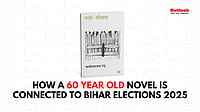IN the nearly 50 years of post-Independence history, three accords have been signed between the Government of India and the government of Jammu and Kashmir. In a number of ways, all three have become documents of discord.
The first of these, of course, was the Instrument of Accession with India signed by Maharaja Hari Singh after the Pakistani-backed tribal invasion of the erstwhile princely state. Even as the Kashmiris rose unitedly against the marauding invaders, the Maharaja realised that they were no match for the well-armed aggressors, and he appealed to India for help. As Sheikh Abdullah himself acknowledged in the Jammu and Kashmir Constituent Assembly later: "In that critical moment, we could turn only to India where the Government and the people had demonstrated their sympathies for the ideals for which we were fighting the raiders."
But the Government of India could not send in its forces to the embattled state without Jammu and Kashmir acceding to the Dominion. And thus with the full backing of the Sheikh's National Conference, the Maharaja signed the Instrument on October 26, 1947, making the state a part of the Indian Dominion. According to the Instrument, the Indian Parliament could make laws for the state in three matters only: Defence, External Affairs, and Communications. In 1952, the first Indian prime minister Jawaharlal Nehru was to describe them as "not subjects, but categories of subjects."
The special Article 370 of the Indian Constitution, conferring special status on Jammu and Kashmir arose out of the Instrument of Accession. With a substantial section of political opinion in the country questioning the special status accorded to Jammu and Kashmir, it can be well understood how the Instrument itself had seeds of discord.
The next important document was the Delhi Declaration agreed upon between the Sheikh and Nehru on July 24, 1952. The eight-point agreement covered a wide variety of subjects ranging from common citizenship, the mode of the appointment of the head of the State of Jammu and Kashmir (then known as the sadr-e-riasat ), the defining of the emergency powers of Article 352 of the Indian Constitution, and the finan-cial arrangement between India and Jammu and Kashmir. But the underlying spirit of the Declaration was still the principle contained in the Instrument of Accession: that without the concurrence of the state assembly, the Indian Parliament could not make laws for the state outside of Defence, Foreign Relations and Communications. Once again, discordant notes were heard almost as soon as the Declaration was made. There were voices of protest not only in New Delhi by right wingers, but even in the Kashmir Valley, where young Farooq Abdullah, then in college, was subjected to jibes from his Muslim friends that his father had sold the people of Kashmir.
However, relations between the Sheikh and New Delhi began to sour shortly after that. Sheikh Abdullah revived the Plebiscite Front, and a little over a year later, on August 9, 1953, he was arrested and Bakshi Ghulam Mohammad installed in his place.
In the years between 1953 and 1975, when the Sheikh was released and he once again took over as the head of the government in Jammu and Kashmir, both the spirit of the Instrument of Accession and the Delhi Declaration suffered grievi-ously as an enfeebled state assembly allowed New Delhi to frame a series of laws which considerably eroded the autonomy of the state. One of the first casualties was the mode of appointment of the sadr-e-riasat , who was rechristened as the Governor in conformity with the practice in other states and was appointed by New Delhi.
The third in the series of important documents—commonly known as the 1975 accord—came after the Sheikh's release from jail. The basis for the accord, of course, was prepared in November 1974 between G. Parthasarathy and Mirza Mohammad Afzal Beg. Besides reiterating that the State of Jammu and Kashmir was a constituent unit of the Union of India, the most important clause (clause 4) of the agreement admit -ted tacitly that some of the laws between 1953 and 1975 had caused an erosion in the state’s autonomy. It was agreed that the "state government can review the laws made by Parliament or extended to the state after 1953 on any matter relatable to the concurrent list, and may decide which one of them...needs amendment or repeal". The document promised that the "grant of the President’s assent to such legislation would be sympathetically considered". It may be pointed out here that Farooq Abdullah's demand of the pre-1953 status has its genesis in the Indira Gandhi-Sheikh Abdullah accord of 1975.
The unwritten agreement of the ’75 accord resulted in the Sheikh winding up the Plebiscite Front. The backlash was immediate. Sofi Mohammad Akbar formed a militant organisation a year later. And even in 1974, as word of the Beg-Parthasarathy agreement leaked out, Fazl Qureshi set up the People’s League. The Sheikh was denounced in Kashmir by those who were staunchly with him in the Plebiscite Front. He was accused of building a palace (read, becoming ruler once again) on the graves of martyrs who had sacrificed their lives for the cause. In many ways, the unpopularity of the Abdullah family now raging in the Kashmir Valley began with the 1975 accord.

























